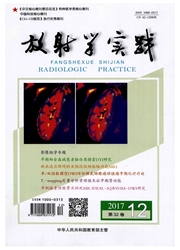

 中文摘要:
中文摘要:
目的:探讨MRI对羊水过少致胎儿肺发育不良的定性和定量诊断价值。方法:病例组包括26例因羊水过少致胎儿肺发育不良的孕妇,年龄21~43岁,平均28岁;孕龄22~36周,平均25周。另选取26例相应孕周胎儿肺发育正常的孕妇作为对照组,产前常规行超声(US)检查后24~48h内行MRI检查,采用稳态自由进动(SSFP)序列和单次激发快速自旋回波(SSTSE)序列T2WI以及快速T1WI序列,将产前MRI、US表现与胎儿出生后影像学或尸检结果进行对照。结果:26例孕妇均诊断为羊水过少,其中泌尿系异常所致22例、胎膜早破所致4例。羊水过少组胎儿肺肝信号强度比(LLSIR)为1.34±0.27,显著低于正常对照组(2.14±0.70),2组间差异有高度统计学意义(P〈0.01)。26例胎儿US均未提示双肺发育不良;对于羊水过少的病因诊断,US漏诊2例、诊断不完全正确3例,MRI均诊断正确。结论:MRI可以量化评价羊水过少致胎儿肺发育不良程度,准确诊断羊水过少病因,是诊断羊水过少合并胎儿异常的较理想的评价方法。
 英文摘要:
英文摘要:
Objective:To study the value of MRI in the qualitative and quantitative diagnosis of fetal oligohydramnios-associated pulmonary hypoplasia. Methods: Twenty-six pregnant women, aged from 21 to 43y (average 28y) and with the gestation period from 22w to 36w (average 25w) were recruited in this study,and 26 normal pregnant women with the same gestation period were collected as the control group. MR scanning was performed within 24 to 48h after ultrasonography (US) study. The MRI sequences included steady state free-precession (SSFP) and single shot turbo spin echo (SSTSE) T2WI,and Ti weighted fast imaging. Prenatal US and MRI findings were compared with postnatal imaging findings or au topsy. Results: Of the 26 cases having oligohydramnios with the cause as urinary tract abnormalities (22 cases) or premature rupture of amnion membrane (4 cases). The mean lung-to-liver signal intensity ratio (LLSIR) of the oligohydramnios (1.34±0.27) on T2 weighted MR imaging was significantly lower than that of the control group (2.14±0.70) ,with sig-nificant statistic difference (P〈0.01). 26 cases of pulmonary hypoplasia were all missed by US. For the diagnosis of the cause of oligohydramnios,two cases were missed by US. US diagnosis was not entirely correct in 3 cases. MRI diagnosis was correct in all 26 cases. Conclusion:The degree of fetal oligohydramnios-associated pulmonary hypoplasia could be quantita-tively evaluated and the cause could be accurately diagnosed by MRI, MRI is a promising method for the assessment of fetal oligohydramnios-associated anomalies.
 同期刊论文项目
同期刊论文项目
 同项目期刊论文
同项目期刊论文
 期刊信息
期刊信息
